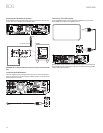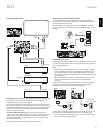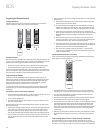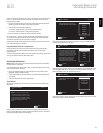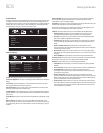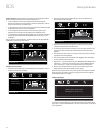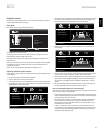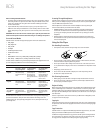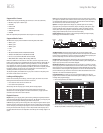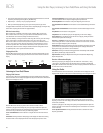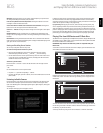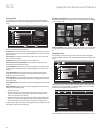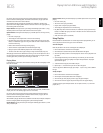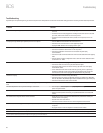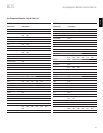
BDS
24
Using the Receiver and Using the Disc Player
Notes on Setting Subwoofer Volume:
Sometimes the ideal subwoofer volume setting for music is too loud for films, while the
t
ideal setting for films is too quiet for music. When setting the subwoofer volume, listen
to both music and films with strong bass content and find a “middle ground” volume
level that works for both.
If your subwoofer always seems too loud or too quiet, you may want to place it in a
t
different location. Placing the subwoofer in a corner will always tend to increase its bass
output, while placing it away from any walls or corners will always tend to lessen its bass
output.
IMPORTANT: Do not turn the receiver’s volume up to or past the point where the
audio from the speakers becomes distorted. Doing so can damage the speakers.
Surround-Sound Modes
Your BDS receiver can decode and play audio programs in these native audio formats:
Dolby Digital
t
Dolby Digital Plus
t
Dolby TrueHD
t
DTS Digital
t
DTS-HD High Resolution Audio
t
DTS-HD Master Audio™
t
PCM
t
WMA (DRM-free version only): WMA9, CBR @192kbps, VBR @ 355kbps
t
MP3: 32kbps – 320kbps bitrates, including variable bitrate encoding
t
The audio formats available for any particular program depend on the program and on how
you have configured your BDS receiver in the Audio Settings menu:
Available Audio Formats
2.0- and 2.1- Channel
Setup Configuration
3.1-Channel Setup
Configuration
5.1-Channel Setup
Configuration
2.1-Channel
Programs
Dolby Virtual Speaker
Wide (default)/Dolby
Virtual Speaker Reference/
Stereo
Dolby PLII Movie
(default)/Dolby PLII
Music/Dolby Virtual
Speaker Wide/Dolby
Virtual Speaker Reference/
Stereo
Original (default)/
Dolby PLII Movie/
Dolby PLII Music/Dolby
Virtual Speaker Wide/
Dolby Virtual Speaker
Reference/Stereo
3.1-Channel
Programs
Dolby Virtual Speaker
Wide (default)/Dolby
Virtual Speaker Reference/
Stereo
Original (default)/ Dolby
Virtual Speaker Wide/
Dolby Virtual Speaker
Reference
Original (default)/
Dolby PLII Movie/
Dolby PLII Music/Dolby
Virtual Speaker Wide/
Dolby Virtual Speaker
Reference/Stereo
4.1-/5.1-
/6.1- Channel
Programs
Dolby Virtual Speaker
Wide (default)/Dolby
Virtual Speaker Reference/
Stereo
Dolby Virtual Speaker
Wide (default)/Dolby
Virtual Speaker Reference/
Stereo
Original (default)/ Dolby
Virtual Speaker Wide/
Dolby Virtual Speaker
Reference
To switch between the available surround-sound modes for the program currently playing,
press the Surround button. Each press of the Surround button will change to the next
available mode in line. A pop-up display will appear on the TV, showing the modes as you
cycle through them.
Listening Through Headphones
Your BDS receiver’s headphone connection accepts a standard 3.5mm stereo headphone plug.
When you insert the headphone plug into the connector, the receiver’s speaker outputs will
mute; the HDMI audio output will not mute.
When headphones are connected to the receiver’s Headphone connector, pressing the
remote’s Surround button cycles between these two modes:
HARMAN Headphone, which virtualizes a multichannel surround soundtrack down to
t
two channels. This mode retains the soundtrack’s original directional cues, allowing
you to enjoy an enveloping surround-sound experience on any ordinary pair of stereo
headphones.
Headphone Bypass, which downmixes surround-sound programs into normal stereo.
t
This mode does not retain any multichannel directional cues that may be in the original
surround-sound program.
Using the Disc Player
Disc Handling Precautions
To keep the disc clean, handle the disc by its edge. Do not touch the surface.
t
Do not stick paper or tape on the disc. If there is glue (or a similar substance) on the disc,
t
remove the substance completely before using the disc.
Do not expose the disc to direct sunlight or heat sources such as hot air ducts, or leave it
t
in a car parked in direct sunlight, as there can be a considerable rise in temperature inside
the car.
After playing, store the disc in its case.
t
Do not write on the label side with a ballpoint pen or other sharp writing utensils.
t
Be careful not to drop or bend the disc.
t
Disc Cleaning Precautions
Before playing, clean the disc with a cleaning cloth. Wipe the disc from the center out.
t
Do not use solvents such as benzene, paint thinner, commercially available cleaners or
t
anti-static spray intended for vinyl LPs.
Regional Coding
BDS receivers sold in the USA are designed only for playback of discs with Blu-Ray Disc region
code A and DVD Region Code 1 information, or for discs that do not contain any region code
information. BDS receivers sold in Europe are designed only for playback of discs with Blu-ray
Disc region code B and DVD Region Code 2 information, or for discs that do not contain region
code information.
If there is a region code on a disc other than the one your BDS receiver is designed for, it will
not play in the receiver’s disc player.
Copyright
Audio-visual material may consist of copyrighted works, which must not be recorded without
the permission of the owner of the copyright. Please refer to relevant laws covering copyright
protection.
Copy Protection
Your BDS receiver is in compliance with HDCP (High-Definition Copy Protection), and a video
display connected via the HDMI output must also be HDCP-compliant.
The BDS receiver supports Macrovision copy protection. On Blu-ray Disc recordings and DVD
discs that include a copy-protection code, if the contents of the disc are copied using a VCR,
the copy-protection code prevents the videotape copy from playing normally.



